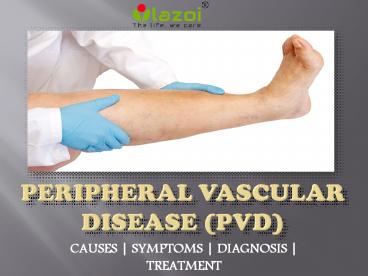Peripheral Vascular Disease (PVD) - PowerPoint PPT Presentation
Title:
Peripheral Vascular Disease (PVD)
Description:
Peripheral Vascular Disease (PVD) is a slow blood circulation disorder that leads to blockage in blood vessels, outside your heart and brain. The blood is not able to circulate properly due to clots in the arteries and veins. – PowerPoint PPT presentation
Number of Views:361
Title: Peripheral Vascular Disease (PVD)
1
Peripheral Vascular Disease (PVD)
- CAUSES SYMPTOMS DIAGNOSIS TREATMENT
2
INTRODUCTION TO PERIPHERAL VASCULAR DISEASE (PVD)
- Includes disorders that alter the natural flow of
blood through the arteries and veins of
peripheral circulation. - Affects the lower extremities much more
frequently that the upper extremities. - Generally, a client with a diagnosis of PVD has
arterial disease (peripheral arterial disease
PAD) rather than venous involvement. - Some clients have both arterial and venous
disease
3
CAUSES OF PERIPHERAL VASCULAR DISEASE (PVD)
- The causes of Peripheral Vascular Disease (PVD)
depend on its type. The organic and functional
Peripheral Vascular Disease (PVD) has separate
causes. - In Organic PVD there is a change in the structure
of blood vessels, causing damage in the tissue,
plaques and inflammation, which causes your blood
vessels to narrow. Common causes of Organic PVD
are - High Blood Pressure
- High Cholesterol
- Smoking
- Diabetes
- Injuries
4
RISK FACTOR OF PERIPHERAL VASCULAR DISEASE (PVD)
- There are several risk factors related to
Peripheral Vascular Disease (PVD), some of the
major factors are listed below - High Blood pressure
- Heart Disease
- Kidney Disease
- Drinking
- Smoking
- Unhealthy Lifestyle
- Stress
- Bad cholesterol
- Overweight
- Lack of Exercise
5
SYMPTOMS OF PERIPHERAL VASCULAR DISEASE (PVD)
- Symptoms of Peripheral Vascular Disease (PVD)
depend on the affected artery. The lack of blood
flow in the artery mostly causes pain in leg
calves, thighs, and hips. The pain generally
starts, with exercise or regressive physical
movement. Sometimes pain also occurs when you are
walking or climbing stairs. Other symptoms of
Peripheral Vascular Disease (PVD) include - Cramps
- Pain in buttock
- Weakness
- Reduced hair growth on legs
- Sore on leg
- Numb and heavy feeling
6
DIAGNOSIS OF PERIPHERAL VASCULAR DISEASE (PVD)
- A diagnostic test may be done for measuring the
pulses in your legs and feet, blood pressure
readings in your leg and arm. The tests done to
diagnose Peripheral Vascular Disease (PVD)
include - X-ray
- MRI
- CT Scan
- BNP Blood test
- Angiography
- Stress test
7
TREATMENTS FOR PERIPHERAL VASCULAR DISEASE (PVD)
- There are a number of medication and surgery
procedures available for the treatment of this
disease. Lifestyle changes such as daily jogging,
losing weight and balanced diet can also help in
the treatment of PVD. - Medicine is given to reduce the painful symptoms,
increase the blood flow, and to keep your
diabetes and cholesterol under control. PVD
medication may include atorvastatin, cilostazal,
clopidogrel. - If medicines alone are not showing any
improvement than following surgeries may be
performed including bypass surgery, angioplasty
and stents, heart valve treatment, heart
transplant.
8
CONNECT WITH US
- Logon to
- www.lazoi.com
- Like us on facebook
- https//www.facebook.com/LazoiTheLife
- Follow us on Twitter
- https//twitter.com/lazoithelife Follow us on
Pinterest - https//in.pinterest.com/lazoithelife/































